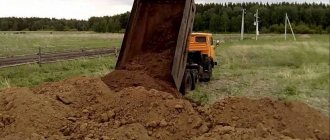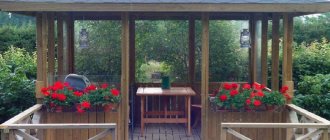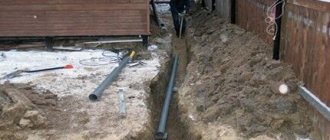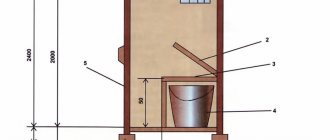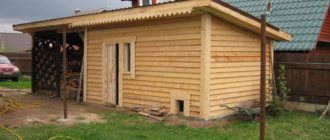To make life at the dacha comfortable, it is necessary to carry out basic communications - water supply and sewerage. In suburban areas there is often no centralized sewerage network, so each house owner solves the problem independently. Periodic use of the home does not require the installation of expensive and complex equipment; it is enough to install a septic tank.
Often in dachas, the function of collecting wastewater is performed by a cesspool. If the house is not equipped with a plumbing system, this option is fully justified, but when installing plumbing fixtures and a large volume of drained water, it is not enough. In this article we will talk about how to make a sewer system in a country house with your own hands in various ways (from concrete rings, barrels, without pumping), and also demonstrate diagrams, drawings, photos and video instructions.
The sewerage system must be built in accordance with the developed project, which includes external and internal piping diagrams.
Sewerage diagram of a country house or dacha The sewerage system
inside the dacha includes in its system the connection points for plumbing fixtures (sinks, shower without a tray, toilet, bathtub), mains and risers; it ends with an outlet pipe located in the area of the foundation.
The external network consists of pipes that drain wastewater from the building and the treatment or storage facility. After preparing the project, you can calculate the size of the pipes, the amount of material for work, and select the type of sewer collector.
Familiarity with the regulatory documents will help you understand how to make a sewer system in your dacha correctly and avoid design mistakes. The diameter of the pipes is selected in accordance with the throughput of the system; a small size will not cope with a significant volume of wastewater, and a large size will require extra money.
Choosing a location for a septic tank
The location of the septic tank is influenced by several factors:
- the terrain of the site, the movement of water is carried out by gravity, so it is important to take into account the slope;
- groundwater depth;
- frost mark in winter;
- location of drinking water supply or water source;
- Soil composition – sandy soil easily allows liquid to pass through, so it can cause groundwater pollution.
Installing a septic tank requires compliance with certain conditions: the distance from the house must be at least 5 meters, the distance from the drinking well is 30 meters, and from green spaces is 3 meters. The place is equipped with the possibility of a sewer truck entering.
Installation of a septic tank for a country house on a turnkey basis in the Zagorod company:
- Departure of a measuring engineer to the site. At this stage, a location for the septic tank is selected taking into account sanitary requirements, the depth of the inlet pipe and the slope of the supply pipe (20 mm per meter). The surveyor draws an installation diagram, the customer receives a detailed estimate with the total amount.
- Delivery of materials and components to the dacha on the day of installation.
- Digging a pit.
- Pouring a concrete slab in the pit and anchoring with stainless steel cables*.
- Sprinkling with cement-sand mixture** or sand and filling with water.
- Laying inlet and outlet pipelines.
- Construction of a filtration field or drainage well.
- Final backfill.
*When installing in a country house with low groundwater, anchoring is not necessary. It is important to follow the operating rule - do not leave the container empty after pumping, so that it does not float up.
**The optimal ratio of sand and cement is usually indicated by the manufacturer in the data sheet.
Work on the installation of internal sewerage
Installation of sewerage inside the building
Having a diagram of the location of all points of the system, and having purchased the necessary material, you can begin its installation. The central riser is installed first. Its diameter is chosen to be about 110 mm, and to remove gases, the upper part protrudes above the roof level or is led into the attic. Two types of pipes are used:
- PVC - the material is chemically resistant, is not subject to corrosion and overgrowing, the smooth inner surface allows drainage to pass through unhindered, installation is carried out using the socket method. PVC prices are quite affordable.
- Cast iron is reliable and durable, but has a large mass and is difficult to install. The cost of such pipes is significantly higher than plastic ones.
- Ceramic - have excellent characteristics, but are expensive.
Sewage outlet 45 degrees
After installing the main riser, located 4 meters from the windows, horizontal pipelines are laid. The ability to monitor the condition of pipes and perform cleaning is provided by inspection hatches, which are located above the toilet and at the lowest point of the system. When installing pipes, avoid turning at a 90-degree angle, which impedes the movement of drains.
Each plumbing fixture must have a siphon with a water seal that prevents the penetration of unpleasant odors into the room. The pipe from the toilet is connected directly, with a pipe of at least 100 mm in diameter.
If a 90-degree rotation device is needed, it can be implemented using two 45-degree corner elements.
To connect the sink and bathtub, pipes with a diameter of 50 mm are sufficient. The lines should be positioned at an angle that allows for water movement. The installation of a sewer system in a dacha involves preliminary preparation of a hole in the foundation for the drainage of the sewer pipe to the outside. A check valve must be installed at the outlet to prevent wastewater from flowing back.
Water supply and sewerage in the country and in the city: differences
Sewage in city apartments can “swallow” quite large objects, food debris, and newspapers without consequences.
But the internal network in private homes is made of small-diameter pipes, and therefore it is much easier to become clogged with foreign objects. Therefore, you should refrain from flushing vegetable and fruit peelings, food scraps, and household garbage down the toilet and sink. The only exception is if a so-called food waste disposer (or chopper) is installed in the sink drain. However, for kitchen sinks, even in crushed form, it is undesirable to drain leftovers from cutting meat, poultry and fish, liquid fat from the deep fryer and from the frying pan, and leftover dough.
Such waste accumulates on the walls of pipes in the form of thick and viscous deposits, reducing the clearance of the pipeline. This ends with the pipe becoming completely impassable. That is why grease traps must be installed on the drain pipes of kitchen sinks and dishwashers. Unfortunately, grease traps are a rarity in private sewers.
The southern regions of our country (Krasnodar Territory, North Caucasus) are characterized by another problem: the growth of roots into underground pipelines. Attracted by the heat of wastewater, microscopic root hairs of trees and shrubs grow through the smallest cracks and joints of pipes and grow in its lumen literally in one season. And within a few years, tree roots can render sewer pipes made of any material completely unusable.
This problem is not uncommon in more northern regions. So, for the sake of preserving the sewage system, it is necessary to lay it at least 3 m from fruit trees and shrubs.
General rules for SNiP
Determining the slope level of a sewer pipe
- During installation, pipes made of the same material are used.
- The pipeline must be sealed.
- The connection between the main line and the riser is made with an oblique cross or tee.
- The slope of a pipe with a diameter of 110 mm is 20 mm, and a pipe size of 50 mm is 30 mm per linear meter.
- For country houses, a non-pressure sewer system is used; the drainage flows by gravity.
- A hidden option for installing pipes is allowed, and the connection to the main riser must be open.
Selection of materials
The main part of the septic tank is the waste chambers, which can be made of a variety of materials:
Septic tanks made of plastic
The most common material for pipelines is a polypropylene pipe of suitable diameter. It is inexpensive, light in weight, has very high strength and is easy to process. If desired, you can also use asbestos-cement, cast iron or other metal pipes - but their service life is significantly shorter than that of polypropylene, and the cost is much higher.
The septic chamber is usually made of plastic or reinforced concrete; in simple cases, brick can be used. Using iron barrels of a suitable size as containers is a bad idea: they not only rot quickly, but also pollute the soil as they rust. The ideal option is industrially manufactured septic tanks, easy to install and reliable in operation.
Construction of a septic tank for a private home - a plastic version of a septic tank Source plastlist.ru
Septic tank installation
A pit has been dug for a cesspool.
If it is not possible to connect the internal sewage system of the dacha to the central one, a septic tank is installed. This device is designed to collect and purify wastewater. Septic tanks differ in design, material and cleaning method. Before installing sewerage in your dacha, you need to decide on the choice of wastewater receiver. To construct septic tanks, the following are used: plastic or metal containers, brickwork, reinforced concrete structures. Treatment of contaminated water is carried out through soil filtration, biological treatment or wastewater is accumulated and pumped out by a sewer machine.
The easiest way is to install a sealed container in which wastewater accumulates; after filling, it is pumped out using special equipment. The disadvantage of this method is the significant costs of regularly ordering the services of vacuum cleaners.
A more complex device has a septic tank that can partially purify wastewater. There are several options for such a device on sale, but their price is quite high. With a little knowledge and a desire to save money, you can make a septic tank yourself.
Polyethylene septic tanks for summer cottages
The cheapest and therefore the most popular for summer cottages. They are made from polyethylene using rotational molding technology. Polyethylene granules are poured into a collapsible mold. It is rotated and heated. The granulate melts and spreads evenly over the mold, forming a hollow, seamless container.
How rotational molding is performed (picture below)
Advantages of polyethylene settling tanks:
- One-piece construction, leak-proof.
- Low price.
- Light weight.
Disadvantages of polyethylene septic tanks for summer cottages:
- Plastic material subject to compression.
- During installation, you need to sprinkle the DSP. These are unnecessary expenses.
These treatment plants are suitable for sandy and sandy loam soils and low groundwater levels. We do not recommend installing such a septic tank with a biofilter in clay or at high groundwater levels. The sprout can be considered an exception, since it has a cylindrical shape that is optimal for difficult soil.
Two-chamber septic tank
Concrete septic tank design
The most convenient is to install a collector of two chambers connected by an overflow pipe. Let's find out how to arrange it yourself.
- Work begins with digging a pit in a place chosen taking into account all sanitary requirements. The volume of the structure depends on the number of people living in the country house. You can dig a pit manually or using an excavator.
- A sand cushion up to 15 cm high is formed at the bottom of the pit. The depth of the pit is 3 meters.
- It is necessary to install formwork made of boards or chipboard. The design must be reliable. Next, a reinforcing belt is formed from metal rods tied with steel wire.
- It is necessary to make two holes in the formwork and insert pipe cuttings. These will be places for the entrance of the sewer main and the overflow pipe between the sections.
- The formwork is filled with concrete, which is distributed throughout the entire volume using a vibrating tool. The design of the septic tank must be monolithic, so it is advisable to fill the entire formwork at one time.
- In the first compartment, the bottom is filled with concrete, a sealed section is formed, which will serve as a sump. Here the wastewater will be separated into large solid fractions that sink to the bottom, and clarified water that flows into the adjacent section. For better decomposition of solid residues, aerobic bacteria can be purchased.
- The second compartment is made without a bottom; it can be made not only from monolithic walls, but also using concrete rings with a diameter of 1–1.5 meters, stacked on top of each other. The bottom of the well is covered with a thick layer of sedimentary rock (crushed stone, pebbles, gravel) to filter the wastewater.
- An overflow pipe is laid between the two sections. It is installed at an angle of 30 mm per linear meter. The height of the pipe is located in the upper third of the wells. The number of sections is not necessarily limited to two; a four-section septic tank can be made, which provides better cleaning.
- The ceiling of the septic tank is made independently, using formwork and concrete, or ready-made reinforced concrete slabs are used. Be sure to install a hatch that allows you to control the filling of sections and the hood. The pit is filled with sand and selected soil. The sump tank of such a system will be cleaned every 2–3 years.
Due to the ease of installation, many summer residents prefer to make a septic tank from concrete rings.
Construction of a two-chamber septic tank made of concrete rings
If the soil on the site is clayey or the groundwater is located very close to the surface, it will not be possible to install a septic tank of this design. You can settle on a sealed container of sufficient volume, securely installed and secured to a concrete slab in the pit.
Installation of an autonomous septic tank Topas
Nuances of arranging a country sewer system
As you know, dacha communities and country villages are located far from large populated areas, so owners of garden houses cannot count on centralized service. The way out of this situation is to organize a separate local system for each suburban area separately.
In elite villages, powerful VOCs are often installed that can simultaneously serve several large cottages, but this is rather an exception to the general rule. More often, owners of garden plots ranging from 6 to 15 acres make do with more modest budget devices - cesspools or simple septic tanks.
Scheme of the simplest sewerage system in a country house: simple internal wiring (sink + toilet), a straight pipe for household waste, a cesspool with an access road for special equipment
Both can be built from inexpensive building or alternative materials, such as:
- factory-made concrete blanks;
- red or white brick;
- cement mortar (to create a sealed monolithic container);
- car tires.
There is another way, more expensive, but quite effective - installing a ready-made factory container made of modified plastic, equipped with a pipe for connection to a pipe, ventilation and a technical hatch.
It is prohibited to dig a drain hole without creating a sealed tank, as this is contrary to sanitary standards. Sewage, teeming with pathogenic bacteria and chemically aggressive substances, goes directly into the soil and groundwater, polluting it.
Option for installing a country street toilet. The cesspool partially extends beyond the “house”, and a technical hatch for emptying the storage tank is located near the building - this makes it possible to do without a pipeline
There is also no point in installing expensive biological treatment stations, since the volume of wastewater will most likely be minimal, and the treatment facility will more closely resemble the same storage tank.
So it turns out that the best option is a large cesspool or a septic tank-type structure. On a large plot there may be several cesspools, for example, a peat pit for an outdoor toilet and two storage tanks - at the bathhouse and at the house.
Laying the external main
The pipe is laid with a certain slope.
From the point where the sewer pipe exits the house to the septic tank, it is necessary to lay a pipeline. The main must lie at a slope that ensures the drainage of contaminated water. The larger the diameter of the pipes you use, the smaller the angle of inclination required for their operation, on average it is 2 degrees. The depth of the trench for laying pipes must be greater than the amount of winter freezing of the soil. If the depth of the trench is small, provide thermal insulation of the line.
The average depth for laying a sewer system is 1 meter; in warm regions it is enough to go down to 70 cm, and in cold regions you will need to dig a pit up to 1.5 meters. The bottom of the dug hole is covered with a dense cushion of compacted sand. This procedure will protect the pipes from soil displacement.
A pit for a septic tank near the fence.
The best option would be to lay a direct pipeline to the collector. If it is necessary to make a turn, this place will be equipped with an inspection well. For the main line, you can use plastic and cast iron pipes with a diameter of 110 mm; their connection must be airtight. After installation, the pipeline is covered with sand and then with soil.
Pipe inspection
Using a television inspection camera on a flexible cable, pushed into the sewer pipe, you can see the true causes of the problem:
- stuck foreign objects;
- tree roots that have grown into the pipe opening;
- improper slope causing accumulation of mineral and organic sediment;
- destruction or displacement of pipes due to corrosion, subsidence of the earth, freezing in winter.
Depending on the results of the video diagnostics, you can consciously decide whether only thorough cleaning is required or repair work is required. If the cause of blockages is the destruction of a section of pipe, then video diagnostics will localize the damaged area with high accuracy: you will not have to dig up the entire pipeline to replace the damaged pipe fragment.
Using video diagnostics, it would also be reasonable to monitor the work of the team that laid or repaired the pipeline. The inspection will reveal all installation errors before the start of sewer operation (failure to comply with slopes, foreign objects in the pipe, soil subsidence), which will allow them to be corrected and most possible problems to be prevented.
If the sewer system does not have chronic “diseases” associated with design and installation errors, it is recommended to carry out preventive cleaning of the pipes once a year. This is usually done at the end of the summer season, before the onset of cold weather.
Septic tank without pumping
The design, which does not require regular pumping of wastewater, consists of several tanks operating simultaneously. These can be two/three-chamber septic tanks. The first tank is used as a sump. It is the largest in volume. In two-chamber septic tanks, the septic tank occupies ¾ of the structure, and in three-chamber septic tanks ½. Here, preliminary wastewater treatment takes place: heavy fractions settle, and light fractions are poured into the next compartment as the first one is filled. In the last part of the septic tank, the final wastewater treatment takes place. The water is then directed to the filtration fields/drainage well.
The first 2 compartments must be sealed. The last chamber has holes in the walls/bottom. In this way, purified water seeps into the ground, which helps avoid systematic pumping of waste without causing irreparable damage to the soil.
It is worth considering that in addition to organic matter, wastewater also contains insoluble impurities. In view of this, such a structure will also have to be pumped out periodically to get rid of the sediment accumulating in the sump. This can be done with a fecal/drainage pump. The frequency of septic tank maintenance depends entirely on the size/volume/composition of wastewater.
Sizing
To independently construct such a septic tank, you need to correctly calculate its volume. It depends on the water consumption of your household. The water consumption rate per person is 200 liters per day. So, multiplying this amount by the number of household members, you will get the daily water consumption in the house. Add another 20% to the resulting figure.
18 m3. In this case, you need a septic tank with a depth and length of 3 m, and a width of 2 m. By multiplying all sides, you get 18 m3. The minimum distance from the bottom of the septic tank to the drain pipe is 0.8 m.
Treatment systems
The advantage of the treatment system is that the sludge is processed by anaerobic bacteria, as a result of which it settles to the bottom in a much smaller volume. Gradually this sediment becomes denser and rises. When the sludge reaches the overflow level, the septic tank must be cleaned immediately. You should resort to cleaning a septic tank quite rarely. This is due to the fact that the volume of sludge in 6 months will be from 60 to 90 liters.
Volatile septic tanks have built-in pumping units. Their non-volatile analogues should be cleaned manually or using sewer equipment.
However, not so long ago, biological products with special enzymes appeared that convert sludge into acid, and then into methane and carbon dioxide. To remove these gases, you just need to install ventilation in the septic tank. Thus, your septic tank will become an absolutely waste-free, safe and energy-independent treatment facility.
Bacteria need to be “fed” with oxygen to make their work more efficient. You can buy containers for a septic tank or make your own.
Installation of a finished septic tank
Before installing the finished septic tank structure, it is necessary to determine a suitable location for this. The minimum distance between the septic tank and the house is 5 m. The sewer pipes leaving the house must be directed directly to the septic tank. It is better to avoid turning the pipeline, because it is in such places that blockages form.
The septic tank should not be installed near trees, as their roots can damage the integrity of the body. The depth of the septic tank and sewer pipes directly depends on the level of soil freezing.
Digging a pit for a septic tank
Advantages of sewerage from
High reliability. Sewage installations for country houses from TOPOL-ECO operate stably for up to 50 years. Different models can serve from 1–200 people.
Possibility to reuse purified water. At the outlet of the installation, you can organize a storage tank and use the treated wastewater for watering lawns, washing paths and other household needs. Quality guarantees. Treatment plants are manufactured in accordance with current state standards. The composition and properties of the outlet water comply with the standards. The affordable cost of installations from TOPOL-ECO and high efficiency distinguish them favorably from the equipment of competing companies.
Sewage system made of concrete rings
If you are not satisfied with a ready-made plastic autonomous system for wastewater treatment, due to its size or cost, then you can make a septic tank from several compartments yourself. An excellent inexpensive material for realizing your plans is concrete rings. You can do all the work yourself.
Advantages and disadvantages of the system
Among the advantages of a septic tank made of reinforced concrete rings, we note the following:
- Affordable price.
- Unpretentiousness during operation.
- Possibility of performing work without the help of specialists.
The following disadvantages deserve attention:
- The presence of an unpleasant odor. It is impossible to make the structure completely airtight, and therefore the formation of an unpleasant odor near the septic tank cannot be avoided.
- The need to clean the chambers of solid waste using sewage disposal equipment.
You can reduce the frequency of the need to pump out the septic tank if you use bioactivators. They reduce the amount of solid fractions by accelerating the process of their decomposition.
If the installation of the rings is carried out incorrectly, the septic tank will not be airtight, which will increase the risk of untreated wastewater penetrating into the ground. But, with proper installation, the septic tank will be sealed, so this disadvantage of the system is rightly called conditional.
Scheme and calculations
The design of a septic tank, as a rule, includes 1–2 chambers designed for settling and purifying wastewater and a filtration field/filter well.
If there are few people living in your house and a minimum of plumbing fixtures are connected to the sewer system, then you can easily get by with a septic tank consisting of one septic tank and a filter well. And vice versa, if you have a lot of household members and many devices are connected to the sewer system, then it is better to make a septic tank from two chambers and a filtration well.
Rings for a septic tank
How to calculate the required volume for a septic tank has already been described above. According to building codes, the septic tank chamber must accommodate a three-day volume of wastewater. The volume of the reinforced concrete ring is 0.62 m3, which means that to build a septic tank for 5 people you will need a septic tank of five rings. Where did this amount come from? For 5 people you need a septic tank with a volume of 3 m3. This figure must be divided by the ring volume equal to 0.62 m3. You will get a value of 4.83. It needs to be rounded up, which means that to install a septic tank in this particular case you will need 5 rings.
Preparatory processes
The pit must be of such a size that it can accommodate septic tank chambers and a filter well. This work, of course, can be done manually, but it takes a long time and is very difficult, so it is more cost-effective to order digging a pit from a company with earth-moving equipment.
The bottom of the pit at the site where the settling chambers are installed must be concreted in order to avoid the possibility of untreated wastewater penetrating into the ground. Before starting concrete work, part of the bottom of the pit should be drained to install settling tanks by laying a sand cushion on it in a layer of 30–50 cm.
If you do not want to concrete the bottom, then you can purchase reinforced concrete rings with a solid bottom. They will need to be installed first in a vertical row.
The place for the filter well also requires preparation of the base. Under it you need to make a cushion of sand, crushed stone and gravel at least 50 cm thick.
Installation of rings
To install the rings, you will have to order the services of lifting equipment. Performing these tasks manually is very difficult. You can, of course, install the rings by digging under the bottom ring. But this method is labor-intensive. And the bottom will have to be filled after installing the last ring, which will entail a number of inconveniences. In view of this, it is better not to save on ordering lifting equipment.
Usually the rings are fastened together with mortar, but for greater structural reliability they can be fastened with metal plates or staples. In this case, your septic tank will not be damaged due to soil movement.
Now it’s time to organize an overflow, and for this you need to connect pipes to the rings. It is better that they work on the principle of a water seal, that is, they need to be installed with a bend.
Fiberglass septic tanks for summer cottages
Fiberglass threads (roving) are impregnated with synthetic resin and wound on a cylindrical mandrel. Winding is done manually or by machine. The case turns out to be very durable. Sidewalls, necks and pipes are made separately and molded to the shell (cylindrical base). If the molding is done poorly, leaks will appear.
How to wind glass fiber by machine (picture below)
Advantages of fiberglass septic tanks for summer cottages:
- Rigid material that can withstand strong soil pressure. You can bury it deeper if the drain pipe is brought out deep.
- The body is cylindrical, the load is distributed evenly.
A fiberglass septic tank can be installed at great depths thanks to its rigid body. This is an important advantage, since the drain pipe is often located deep in the house.
Disadvantages of fiberglass septic tanks:
- The sides and necks are molded by hand. Possible manufacturing defect.
- Expensive due to complex technology and cost of materials.
- There is no pumping chamber or additional equipment. Installation in clay and at high groundwater levels is expensive
Device for cleaning waste from barrels
The system for treating wastewater from barrels, like a similar structure made of reinforced concrete, can be two- or three-chamber. Sewage will flow into it by gravity, so it must be installed below the sewer pipes. The operating principle of this device is similar to the design of reinforced concrete rings.
Barrel selection
To set up an autonomous sewerage system based on the principle of a treatment system, you can use any containers. These could be old metal/plastic barrels. The main thing is that they are airtight.
If you decide to make a septic tank from metal barrels, then they should be pre-treated with an anti-corrosion agent.
Pipe supply
Plastic containers have a number of advantages over their metal counterparts:
- A wide range of plastic containers that can be used to equip a septic tank.
- The barrels are highly resistant to the aggressive effects of wastewater. Therefore, they last longer than their metal counterparts.
- The light weight of the containers simplifies their installation at a permanent location.
- Plastic does not require additional processing, unlike metal.
- The high tightness of the barrels eliminates the possibility of dirty water penetrating into the ground.
Plastic barrels must be securely fastened when installed in the ground, because due to spring floods or winter frosts they can be squeezed out of the ground. In view of this, plastic barrels are secured with cables to a concrete base (it must first be poured or a reinforced concrete slab must be installed). To avoid crushing plastic barrels, backfilling of soil should be done extremely carefully.
For seasonal use, sewerage from metal barrels is also suitable, but for stationary use this is not an option.
Metal barrels
The popularity of metal containers for sewerage installations is associated with their compactness and ease of installation. As a lid, you can use an appropriately sized piece of wood or one provided by the manufacturer. To install a metal septic tank, you need to dig a corresponding pit, which also needs to be concreted - the walls and bottom.
Metal containers do not have a long service life even after they are treated with anti-corrosion compounds. Therefore, installing them as a septic tank may be unprofitable. Buying stainless steel containers is not an option, as these products are very expensive.
Maybe you decide that in this case you can buy barrels with thin walls. However, this is also not the best solution, since during operation such a septic tank can be pushed out. And such barrels have a limited capacity - up to 250 liters, which is not suitable for a large family.
To install a reliable wastewater treatment system, it is better to use factory-made polymer barrels.
Materials and tools
To make a septic tank from 220 liter barrels, you will need the following materials:
- geotextiles – 80 m2;
- sewer pipe Ø110 m, length 5 m;
- crushed stone fraction 1.8–3.5 cm, approximately 9 m3;
- corner for sewerage at an angle of 45 and 90º – 4 pcs.;
- plastic barrel with a volume of 220 l – 2 pcs.;
- coupling, flange – 2 pcs.;
- wooden peg – 10 pcs.;
- Y-shaped sewer tee – 4 pcs.;
- building level;
- drainage perforated pipe in the filter 5 m – 2 pcs.;
- epoxy two-component sealant – 1 pc.;
- glue for PVC – 1 pc.;
- plumbing tape – 1 pc.
Tools you will need:
- Shovel.
- Electric jigsaw.
- Rake.
Features of installation of plastic containers
For a dacha/small country house, if used sparingly, standard plastic barrels are suitable. Installing such a cleaning system is not difficult. If you do not pour black waste into the sewer, the septic tank will be unpretentious in maintenance. If there is a toilet in the house, then the sewer will have to be cleaned regularly by calling a sewer service.
For private homes with permanent residence, barrels will not be enough. For sewerage, it is better to purchase plastic cubes/tanks/tanks. The process of installing them in the ground is no different from installing barrels.
Plastic barrel
The distance of the septic tank from the house should not exceed 15 m. Too much distance will complicate the process of connecting the sewerage system to the house:
- there is a need for a large depth of the pipeline;
- On the way to the septic tank you will need to install an inspection well.
Features of installing metal barrels
A sewerage system made from metal barrels does not require large financial investments or complex installation work. To begin with, as in previous cases, you need to prepare a pit, and then install 2 barrels, each of which has a volume of at least 200 liters. Then pipes are installed to transfer liquid from one barrel to another and transfer to the filtration fields/drainage well.
Each subsequent container must be located below the previous one in level.
The joints must be sealed, and the barrels must be insulated using polystyrene foam. After this, the pit and septic tank are filled up. Since, as mentioned above, metal barrels do not last long, you need to be prepared for the fact that after 3-4 years they will need to be replaced.
After watching the video and completing all the work correctly, all that remains is to check the system and enjoy the benefits of civilization.
We recommend that you read:
- Do-it-yourself septic tank from a Eurocube (diagram).
- How to defrost a sewer pipe using chemicals.
Advantages of autonomous sewerage
Treatment facilities operating on the principle of deep biological processing of wastewater are used at various facilities: from small houses to boarding houses and mini-hotels. Advantages of this type of autonomous sewage system:
- purification degree up to 98%;
- no costs for ongoing maintenance;
- maintaining tightness for several decades;
- no odor;
- quick installation in any soil;
- excellent sanitary condition of the site.
Photo
Digging a hole Laying an external pipe
Pipe laying
Layout of sewer pipes
Formwork for a concrete septic tank
Concrete septic tank
Concrete cesspool
Formwork for the lid Concreting a septic tank Septic tank from Eurocubes Sewerage from rings
Installing Hole Rings
Installation of several wells Brick septic tank
Autonomous septic tank for a summer residence
The sewage system at the dacha is decorated
So, we can answer the question, which septic tank is better for a dacha:
- In case of high groundwater and clayey soil, it is better to install Eurolos ECO and other settling tanks made of polypropylene.
- In dry sandy soil and low groundwater level, you can install septic tanks made of Rostock or Termit polyethylene.
- For any soil and when the pipeline is deep, fiberglass septic tanks Baikal or Flotenk STA are suitable. They can be buried at great depths and will withstand soil pressure.
The managers of the Zagorod company, as well as our measuring engineer, will help you choose a septic tank for your dacha. He will visit your dacha before installation and determine the conditions in which the sewage system will operate (what kind of soil, how high is the groundwater). If conditions permit, the engineer will advise you on a suitable septic tank. If the conditions are difficult (clay, high groundwater level), then he will recommend a biotreatment station.
Scheme
Scheme of an autonomous wastewater treatment system
Homemade brick septic tank
Operating principle of the drainage field
The principle of sewerage
Scheme of operation of a three-chamber septic tank
The principle of operation of the Alta Bio 5 septic tank A septic tank from two tanks
Septic tank diagram without pumping
Septic tank with filter well
Biological treatment plant diagram
Scheme of waste flow Design of filter fields
The principle of water purification
Did the article help you?
What do manufacturers offer?
The industry offers various models of septic tanks for summer cottages without pumping in the form of miniature and full-fledged systems.
- “Triton mini” is an option for two people. Compact, lightweight system that can be transported in a car. Cleaning is carried out by bacteria. To reach the planned capacity, it takes a couple of days for a certain volume of liquid to accumulate and the process to start.
Design and principle of operation of the Triton mini-septic tank Source vse-o-kanalizacii.ru
- “Tank 1” is one of the models in the “Tank” line, with the most compact size (1 m³), capable of processing 0.6 m³ per day. Handles water consumed by three people. The containers are made of material with thick walls with stiffening ribs. Reliable and functional model.
- “Sprout mini” is a cylindrical container divided into 2 chambers. The structure of the tank is cast, without seams, with stiffening ribs to strengthen the structure. A purification quality of 80% is achieved by a biofilter installed in the system.
- “Topol” is a Russian-made system made using German technology. Equipping the equipment with Japanese mini-compressors increases the efficiency of the system. It has a large range of models, from which it is easy to choose the appropriate option, including mini ones. The body is made of environmentally friendly materials, durable, with a thickness of polypropylene sheets of 1.5 cm.
- "Bars-Aero" is a patented Russian-made system. This is our own development, together with scientists from MGSU. Has a wide operating temperature range (from -40 to +60 C). It is easy to maintain and has a well-thought-out design that allows you to avoid cases of disruption to the operation of the station itself. And the station’s compressor itself is located outside of it, which allows you to extend its service life and saves you money on its expensive repairs. You can more clearly see the main advantages of Bars-Aero in the picture below.
Comparison of the BARS-Topas septic tank with other offers on the market Source erkas.ru



